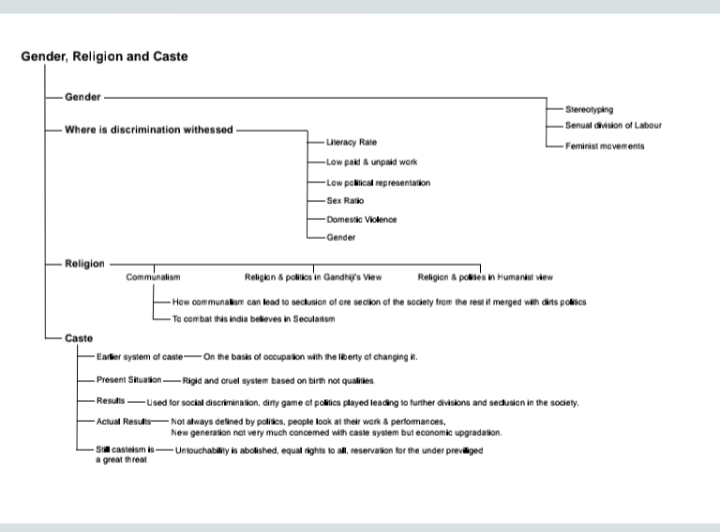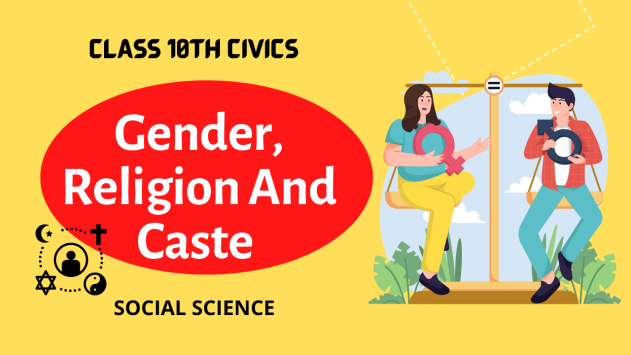We have shared detailed notes about Gender, Religion, And Caste in Class 10th to help the students of class 10th with the lesson to gain conceptual knowledge and grasp all the topics of class 10th Social Science Gender, Religion, And Caste.
We have also shared NCERT Solutions For Class 10th Gender, Religion, And Caste to help out the students of class 10th with the lesson and make them ready how to attempt the questions in the board examinations.
Gender, Religion, And Caste Class 10th: Introduction
Gender and Politics
Gender Division refers to the discrimination against women that considers women as
inferior to men and incapable of doing certain tasks considered to be the preserve of men.
A sexual division of labor is experienced in human society. Very little contribution of
women is seen in public life, especially in politics.
The political expression of gender division and political mobilization has helped improve
women’s role in public life.
Women in India face disadvantages, discrimination, and oppression in various ways.
The literacy rate among women is only 54% compared to 76% among men. Similarly,
a smaller proportion of girl students go for higher studies.
The proportion of women in highly paid and valued jobs is still very small.
The Equal Wages Act provides that equal wages should be paid for equal work.
However, in most areas of work, women are paid less than men, even when both do
exactly the same work.
Sex-selective abortion in India has led to a decline in the child sex ratio (number of girl
children per thousand boys) in the country to merely 927.
Various kinds of harassment, exploitation and violence against women are reported in
both the public and the private sphere.
Women’s Political Representation
In India, the proportion of women in the legislature has been very low. The percentage of elected women members in the Lok Sabha is 10 % of its total strength. Their share in the state assemblies is less than 5 %.
Under the Panchayati Raj system, one-third of seats in panchayats and municipalities are now reserved for women.
Women organizations and activists have been demanding a similar reservation of at least one-third of seats in the Lok Sabha and the State Assemblies for women. This proposal has been pending before the government for more than a decade.
Religion and Politics
Religious differences are often expressed in the field of politics.
Gandhi believed that religion can never be separated from politics. Most victims of
communal riots in our country are people from religious minorities. They have demanded
that the government take special steps for protecting religious minorities.
The women’s movement demands that the family laws of all religions should not discriminate against women.
People should be able to express in politics their needs, interests, and demands as a member of a religious community.
Communalism
Is based on the idea that religion is the principal basis of a social community.
Followers of a particular religion must belong to one community with the same
fundamental interests.
Communalism can take many forms in politics.
Religious prejudices, stereotypes of religious communities, and belief in the
superiority of one’s religion over other religions are commonly experienced.
Communalism demands dominance of one’s own religious community. For those
belonging to the majority community, this takes the form of majoritarian dominance.
For those belonging to the minority community, it can take the form of a desire to
form a separate political unit.
Political mobilization on religious lines involves a special appeal to the interests
or emotions of voters of one religion in preference to others.
Communalism can take the form of communal violence, riots, and massacre.
Secular State
India is a secular state because:
There is no official religion in the Indian State
The Constitution provides to all individuals and communities freedom to profess,
practice and propagate any religion, or not follow any
The Constitution prohibits discrimination on grounds of religion
The Constitution allows the state to intervene in matters of religion in order
to ensure equality within religious communities.
Caste Inequalities
Caste division is special to India. The caste system was based on the exclusion of and discrimination against the ‘outcast’ groups. They were subjected to the inhuman practice of untouchability.
With economic development, large-scale urbanization, growth of literacy and education,
occupational mobility, and the weakening of the position of landlords in the villages, the old notions of caste hierarchy are breaking down.
The Constitution of India prohibited any caste-based discrimination and laid the foundations of policies for reversing the injustices of the caste system.
Even now most people marry within their own caste or tribe. Untouchability has not ended completely, despite constitutional prohibition.
Caste in Politics
Caste can take various forms in politics.
When parties choose candidates in elections, they keep in mind the caste
composition of the electorate and nominate candidates from different castes so as
to muster the necessary support for winning elections.
When governments are formed, political parties usually take care of the
representatives of different castes and tribes to find a place in them.
During elections, political parties and candidates make appeals to caste sentiment
to muster support. Some political parties are known to favor some castes and are
seen as their representatives.
Universal adult franchise and the principle of one-person-one-vote compelled
political leaders to gear up for the task of mobilizing and securing political
support. It also brought new consciousness among the low caste people.
The Indian Constitution is however not caste biased.
No parliamentary constituency in the country has a clear majority of one single
caste. Hence, every candidate and party needs to win the confidence of more than
one caste and community to win elections.
No party wins the votes of all the voters of a caste or community. Caste as a ‘vote
bank’ of one party usually means that a large proportion of the voters from that
caste vote for that party.
Many political parties may put up candidates from the same caste (if that caste is
believed to dominate the electorate in a particular constituency). Some voters
have more than one candidate from their caste, while many voters have no
candidate from their caste.
The ruling party and the sitting MP or MLA frequently lose elections in our
country. That could not have happened if all castes and communities were frozen
in their political preferences.
Politics in Caste
Each caste group tries to become bigger by incorporating within it neighboring castes or sub-castes which were earlier excluded from it.
Various caste groups enter into coalitions with other castes or communities and thus enter into a dialogue and negotiation.
New kinds of caste groups have come up in the political arena such as the ‘backward’ and ‘forward’ caste groups.
Gender, Religion, And Caste Class 10th: Mind Map
We have shared the mind map of class 10th Gender, Religion, And Caste Class 10th to help the class 10th students to get the gist of the lesson on gender, religion, and caste. Mind maps are most useful to remember the concepts of any lesson.
NCERT Solutions For Class 10th Gender, Religion, And Caste
Q1. Mention different aspects of life in which women are discriminated against or disadvantaged in India.
Some of the different aspects of our life in which women are discriminated against or disadvantaged in India are:
a) Education: Education is one of the most important factors in which women are discriminated against in our country. In India, the literacy rate of women is still lower than men. If we check the facts there are only 54% of the women are literate against 76% literacy among men.
b) Proportion of women in paid jobs: The job proportion of women still have a small share in the highly paid jobs. Women are many hard workers than men even though on average an Indian woman works one hour more than an average man every day but still work of a woman did not get that much importance due to which they have to work for low pay
c) Preference for a male child: In India, still, the mentality of many did not change. They still prefer sons over daughters and find ways of aborting girl child. This abortion has led to a decline in the child sex ratio.
d) Crime against women: Women in our country are not safe. The crime rate against women is very high. Women get exploited and harassed at the workplace and also in their homes.
Q2. State different forms of communal politics with one example each.
Different forms of communal politics are as follows:
a) The most common expression of communalism is in everyday beliefs. Belief in the superiority of one’s religion over other religions is so common. E.g.: Militant religious groups
b) A communal mind often leads to a quest for the political dominance of a religious community. For those belonging to a community, it can take them out of a desire to form a separate political unit. g.: Separatist leaders and political parties in Jammu and Kashmir
c) The most frequent form of communalism is political mobilization on religious guidelines. It attempts to bring the people of one’s religion E.g.: Many politicians use this technique to influence the voters from the two largest religious communities in the country.
d) Communalism can be ugliest if it takes the shape of communal violence, riots, and massacre. g.: India and Pakistan communal riots
Q3. State how caste inequalities are still continuing in India.
Caste inequalities roots yet not completely finished in our country. Most people or families still get married to their own caste or tribe. This caste inequality in our country still leads to untouchability among various social groups.
Education is yet not easily available to the people belonging to low castes. Economic status is also closely linked to the caste system These factors and facts are enough to say that the caste system and caste inequalities are still prevailing in our country.
Q4. State two reasons to say that caste alone cannot determine election results in India.
Two reasons to say that caste alone cannot determine election results in India are: (i) In our country, no parliamentary constituency has a clear majority of one single caste. So every candidate and party tries to win the confidence of more than one caste and community.
If these parties and the candidate win the confidence of people belonging to various different castes then it is easy for them to win the elections (ii) It is also true that no party wins the votes of all the voters of a caste or community.
Many political leaders and people refer that a caste as a ‘vote bank’ of one party. This simply means that people from that particular caste or community will vote in a large proportion for that party or that particular candidate.
Q5. What is the status of women’s representation in India’s legislative bodies?
The status of women’s representation in India’s legislative bodies in India are as follows: In Lok Sabha: 10% or less than 10% In assemblies: Less than 5% .
Q6. Mention any two constitutional provisions that make India a secular state.
In India, it is very difficult to make it a secular state as communalism has always been a major threat and challenge to the spirit of democracy. Our constitution has made many provisions to make our country a secular state.
Two of the most important provisions that make our country a secular state are the followings:
(i) One of the most important provisions is Fundamental rights under the Right to freedom of religion as this gives the right to citizens to follow, choose, practice, and propagate any religion. (ii) Another provision that is useful in making our country secular is that our constitution prohibits discrimination on grounds of religion under cultural and educational rights.
Conclusion
We have shared detailed notes on Gender, Religion, And Caste Class 10th to help the students of class 10th to help them with the notes of the class 10th Gender, Religion, And Caste. We have also shared NCERT Solutions for class 10th Gender, Religion, And Caste to help the students to get their doubts related to writing answers and gain conceptual knowledge.
Related Articles
- Political Parties Class 10th Social Science
- Nazism And The Rise Of Hitler Class 9 Social Science
- Socialism In Europe And The Russian Revolution Class 9 Social Science

